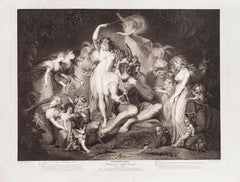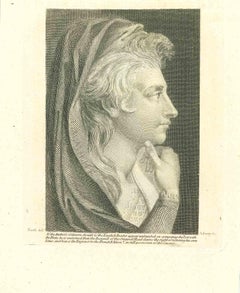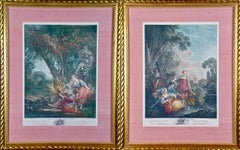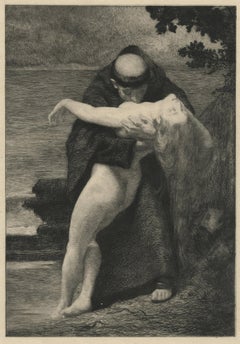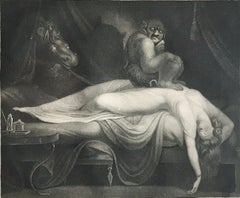Johann Heinrich Fussli (After) Figurative Prints
to
1
1
1
Overall Width
to
Overall Height
to
1
2
859
382
378
308
2
2
1
1
2
2
2
1
1
2
1
Artist: Johann Heinrich Fussli (After)
Shakespeare's Midsummer-Night's Dream- Etching-J.P. Simon After J.H. Fussli-1796
By Johann Heinrich Fussli (After)
Located in Roma, IT
Midsummer-Night's Dream is an original etching engraved by Jean Pierre Simon after the iconic romantic painting by Heinrich Füssli in 1790.
Titled on plate: Midsummer-Night's Dream, Act IV, Scene I: A wood - Titania, Queen of the fairies, Bottom, fairies attending
Mint conditions with little tears along the margin, and a glued tear in the center. Some light little foxings.
The original oil painting is displayed at Tate Britain in London. It was commissioned for the Boydell Shakespeare...
Category
1790s Romantic Johann Heinrich Fussli (After) Figurative Prints
Materials
Etching
Profile of the Woman - Original Etching after H. Fussli - 18th Century
By Johann Heinrich Fussli (After)
Located in Roma, IT
Profile of the Woman is an original etching artwork realized after Heinrich Fussli for Johann Caspar Lavater's "Essays on Physiognomy, Designed to Promote the Knowledge and the Love ...
Category
18th Century Modern Johann Heinrich Fussli (After) Figurative Prints
Materials
Etching
Related Items
Pair of Hand-colored Romantic French Engravings after Francois Boucher
By (After) Francois Boucher
Located in Alamo, CA
A pair of French classical romantic prints original created in the 18th century by Jacques-Firmin Beauvarlet (1731-1797) after paintings by Francois Boucher (1703-1770), utilizing ...
Category
18th Century Romantic Johann Heinrich Fussli (After) Figurative Prints
Materials
Engraving, Etching
$2,375
H 28.5 in W 23.63 in D 1.13 in
Phrosine and Mélidore
Located in Fairlawn, OH
Phrosine and Mélidore
Etching, 1879
Signed in the polate lower left of image
This etching is after the Dantan painting, a copy after the Pierre-Paul Prud’hom painting
Published by Vv...
Category
1870s Romantic Johann Heinrich Fussli (After) Figurative Prints
Materials
Etching
The Princess in her tower David Hockney Six Fairy Tales from the Brothers Grimm
By David Hockney
Located in New York, NY
One of David Hockney’s Six Fairy Tales from the Brothers Grimm illustrations, taken from the story of ‘The Little Sea Hare’. This tower was likely inspired by Hockney’s travels throu...
Category
1960s Modern Johann Heinrich Fussli (After) Figurative Prints
Materials
Etching, Aquatint
$2,000
H 24.75 in W 17.75 in
Catherina Dorothea Viehmann David Hockney Fairy Tales from the Brothers Grimm
By David Hockney
Located in New York, NY
The frontispiece for Hockney’s Six Fairy Tales from the Brothers Grimm portfolio and book features Catherina Dorothea Viehmann, the elderly German woman who recounted fairy tales to ...
Category
1960s Modern Johann Heinrich Fussli (After) Figurative Prints
Materials
Etching, Aquatint
$850
H 24.75 in W 17.75 in
Ballet Dancer
Located in San Francisco, CA
This artwork "Ballet Dancer" 1989 is a color offset lithograph by American artist Robert Olson. It is hand signed and numbered 140/1275 in gold felt pen. ...
Category
Late 20th Century Romantic Johann Heinrich Fussli (After) Figurative Prints
Materials
Lithograph
Heart
By Jim Dine
Located in Winterswijk, NL
Color offset lithograph
Made for an exhibition at the Galerie Maeght
Paris, 12 April - 20 May 1983.
Image in great condition, marginal defects
Category
1980s Romantic Johann Heinrich Fussli (After) Figurative Prints
Materials
Lithograph
The Princess after many years in the Glass Mountain by David Hockney fairy tale
By David Hockney
Located in New York, NY
This etching from David Hockney’s celebrated Six Fairy Tales from the Brothers Grimm portfolio depicts the somewhat obscure story Old Rinkrank, which Hockney chose to illustrate beca...
Category
1960s Modern Johann Heinrich Fussli (After) Figurative Prints
Materials
Etching, Aquatint
$1,100
H 24.75 in W 17.75 in
The Wrath of Elihu: 'I Am Young, And Ye Are Very Old, Wherefore I Was Afraid.'
By William Blake
Located in Storrs, CT
The Wrath of Elihu. 'I Am Young, And Ye Are Very Old, Wherefore I Was Afraid'. 1823-25. Engraving. .Binyon catalog 117 state ii, Bindman catalog 632. Image 7 7/8 x 5 15/16; plate 8 ...
Category
Early 19th Century Romantic Johann Heinrich Fussli (After) Figurative Prints
Materials
Engraving
William BlakeThe Wrath of Elihu: 'I Am Young, And Ye Are Very Old, Wherefore I Was Afraid.', 1923-25
$2,800 Sale Price
20% Off
H 8.63 in W 6.53 in D 0.5 in
Collaborative Etching With 6 artist Hand Signed by 3 artists inc. Dorothy Dehner
By Adolph Gottlieb
Located in New York, NY
Adolph Gottlieb, David Smith, Dorothy Dehner, Edgar Levy, Lucille Corcos and Esther Gottlieb
Collaborative Etching With 6 artist (Hand Signed by 3 artist), ...
Category
Mid-20th Century Modern Johann Heinrich Fussli (After) Figurative Prints
Materials
Etching
$5,000
H 14.25 in W 12.75 in D 0.4 in
Notre Dame de Paris in Winter
By Liudmila Kondakova
Located in San Francisco, CA
This artwork titled "Notre Dame De Paris in Winter" is an original serigraph by Russian artist Liudmilia Kondakova, born 1956. It is signed and numbered 321/325 in gold felt pen by t...
Category
Late 20th Century Romantic Johann Heinrich Fussli (After) Figurative Prints
Materials
Other Medium
From the Barcelona suite
By Sunol Alvar
Located in San Francisco, CA
Artist: Alvar
Title: From Barcelona Suite
Year: 1979
Medium: Color lithograph with embossing
Edition: Numberd 145/185 in pencil
Paper: Arches
Image siz...
Category
1970s Romantic Johann Heinrich Fussli (After) Figurative Prints
Materials
Lithograph
Le Vieux Chalet
By Liudmila Kondakova
Located in San Francisco, CA
This artwork titled "Le Vieux Chalet" is an original serigraph by Russian artist Liudmilia Kondakova, born 1956. It is signed and numbered 90/100 in in white pencil by the artist. Th...
Category
Late 20th Century Romantic Johann Heinrich Fussli (After) Figurative Prints
Materials
Other Medium
Previously Available Items
The Nightmare - Original Etching by Laurède After J.H. Fussli - 1782
By Johann Heinrich Fussli (After)
Located in Roma, IT
The Nightmare is an original etching engraved by Laurède after the iconic romantic painting by Heinrich Füssli in 1782. It is considered as one of the key paintings of Romanticism as...
Category
1780s Romantic Johann Heinrich Fussli (After) Figurative Prints
Materials
Etching
H 8.27 in W 9.45 in D 0.08 in
Johann Heinrich Fussli (after) figurative prints for sale on 1stDibs.
Find a wide variety of authentic Johann Heinrich Fussli (After) figurative prints available for sale on 1stDibs. You can also browse by medium to find art by Johann Heinrich Fussli (After) in etching and more. Much of the original work by this artist or collective was created during the 18th century and is mostly associated with the modern style. Not every interior allows for large Johann Heinrich Fussli (After) figurative prints, so small editions measuring 6 inches across are available. Johann Heinrich Fussli (After) figurative prints prices can differ depending upon medium, time period and other attributes. On 1stDibs, the price for these items starts at $509 and tops out at $1,677, while the average work can sell for $1,093.
